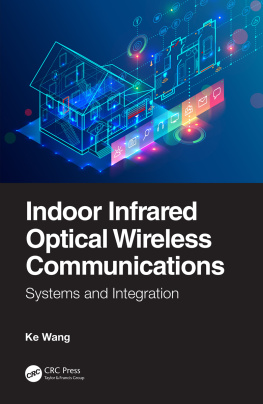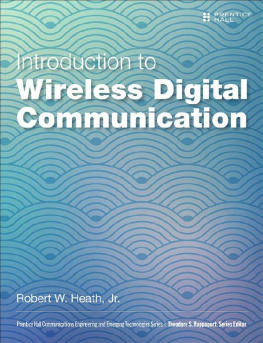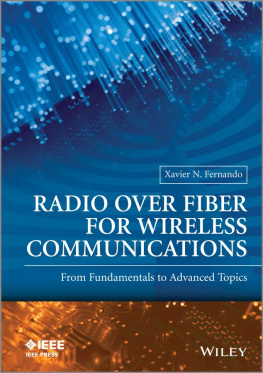Introduction to Wireless Systems
Bruce A. Black
Philip S. DiPiazza
Bruce A. Ferguson
David R. Voltmer
Frederick C. Berry

Upper Saddle River, NJ Boston Indianapolis San Francisco
New York Toronto Montreal London Munich Paris Madrid
Capetown Sydney Tokyo Singapore Mexico City
Many of the designations used by manufacturers and sellers to distinguish their products are claimed as trademarks. Where those designations appear in this book, and the publisher was aware of a trademark claim, the designations have been printed with initial capital letters or in all capitals.
The authors and publisher have taken care in the preparation of this book, but make no expressed or implied warranty of any kind and assume no responsibility for errors or omissions. No liability is assumed for incidental or consequential damages in connection with or arising out of the use of the information or programs contained herein.
The publisher offers excellent discounts on this book when ordered in quantity for bulk purchases or special sales, which may include electronic versions and/or custom covers and content particular to your business, training goals, marketing focus, and branding interests. For more information, please contact:
U.S. Corporate and Government Sales
(800) 382-3419
For sales outside the United States please contact:
International Sales
Visit us on the Web: www.informit.com/ph
Library of Congress Cataloging-in-Publication Data
Introduction to wireless systems / Bruce A. Black ... [et al.].
p. cm.
Includes bibliographical references and index.
ISBN 0-13-244789-4 (hardcover : alk. paper)
1. Wireless communication systems. I. Black, Bruce A.
TK5103.2.I62 2008
621.384dc22
2008005897
Copyright 2008 Pearson Education, Inc.
All rights reserved. Printed in the United States of America. This publication is protected by copyright, and permission must be obtained from the publisher prior to any prohibited reproduction, storage in a retrieval system, or transmission in any form or by any means, electronic, mechanical, photocopying, recording, or likewise. For information regarding permissions, write to:
Pearson Education, Inc.
Rights and Contracts Department
501 Boylston Street, Suite 900
Boston, MA 02116
Fax: (617) 671-3447
ISBN-13: 978-0-13-244789-8
ISBN-10: 0-13-244789-4
Text printed in the United States on recycled paper at Courier in Westford, Massachusetts.
First printing, May 2008
Dedication
This book is dedicated to Misty Baker, the Founding Director of the Global Wireless Education Consortium (GWEC), and to her successor, Susan Sloan, Executive Director of GWEC, for their tireless efforts in promoting the academic disciplines central to wireless communications. Their encouragement not only provided inspiration for this book, but also established the venue for the authors to launch its creation and to become sincere friends.
Preface
This text is intended to provide a senior undergraduate student in electrical or computer engineering with a systems-engineering perspective on the design and analysis of a wireless communication system. The focus of the text is on cellular telephone systems, as these systems are familiar to students; rich enough to encompass a variety of propagation issues, modulation techniques, and access schemes; and narrow enough to be treated meaningfully in a text that supports a single course. The presentation is limited to what cellular systems engineers call the "air interface" and what network engineers call the "physical layer."
The presentation is unique in a number of ways. First, it is aimed at undergraduate students, whereas most other textbooks written about wireless systems are intended for students either at the graduate level or at the community college level. In particular, the presentation combines a clear narrative with examples showing how theoretical principles are applied in system design. The text is based on ten years' experience in teaching wireless systems to electrical and computer engineering seniors. The lessons learned from their questions and responses have guided its development. The text not only presents the basic theory but also develops a coherent, integrated view of cellular systems that will motivate the undergraduate student to stay engaged and learn more.
Second, the text is written from a systems-engineering perspective. In this context a "system" comprises many parts, whose properties can be traded off against one another to provide the best possible service at an acceptable cost. A system with the complexity of a cellular network can be designed and implemented only by a team of component specialists whose skills complement one another. Top-level design is the responsibility of systems engineers who can translate market requirements into technical specifications, who can identify and resolve performance trade-off issues, and who can set subsystem requirements that "flow down" to the subsystem designers. The text introduces students to the concept that specialists from a wide range of engineering disciplines come together to develop a complex system. Theory and contemporary practice are developed in the context of a problem-solving discipline in which a divide-and-conquer approach is used to allocate top-level functional system requirements to lower-level subsystems. Standard analysis results are developed and presented to students in a way that shows how a systems engineer can use these results as a starting point in designing an optimized system. Thus an overlying systems-engineering theme ties together a wide variety of technical principles and analytical techniques.
This text comprises eight chapters. An introductory chapter sets out the systems-engineering story. introduces the principle of frequency reuse and the resulting cellular system structure. The goal of this chapter is to show how a communication system can be extended to provide service over a virtually unlimited area to a virtually unlimited number of subscribers.
Once a power link is established, information must be encoded to propagate effectively over that link. also introduces spread-spectrum modulation, emphasizing the ability of spread-spectrum systems to provide robust communication in the presence of narrowband interference and frequency-selective fading.
On completion of introduces methods for multiple access, including FDMA, TDMA, and an introduction to CDMA. The ability of spread-spectrum systems to support multiple users over a single channel is emphasized.
Wireless systems carry information from a wide variety of sources, from speech to music to video to short text messages to Internet pages. When digitized, information from various sources produces data streams with differing properties. Further, subscribers apply different criteria to assessing the quality of different kinds of received information..
This text has been written to support a one-term senior elective course. It is assumed that students taking the course will have completed conventional courses in signals and systems and an introduction to communication systems. The signals and systems background should include a thorough introduction to the Fourier transform. It is also assumed that readers of the text will have completed an introductory course in probability, including coverage of probability density functions, expectations, and exposure to several conventional probability distributions. The material included in this text should be more than sufficient to support a one-semester course. At Rose-Hulman Institute of Technology the book is used to support a one-quarter course that includes four instructional meetings per week for ten weeks. The course covers all of is included as time permits.









